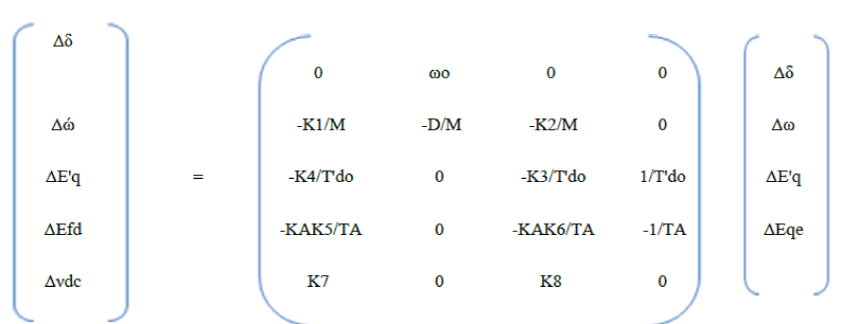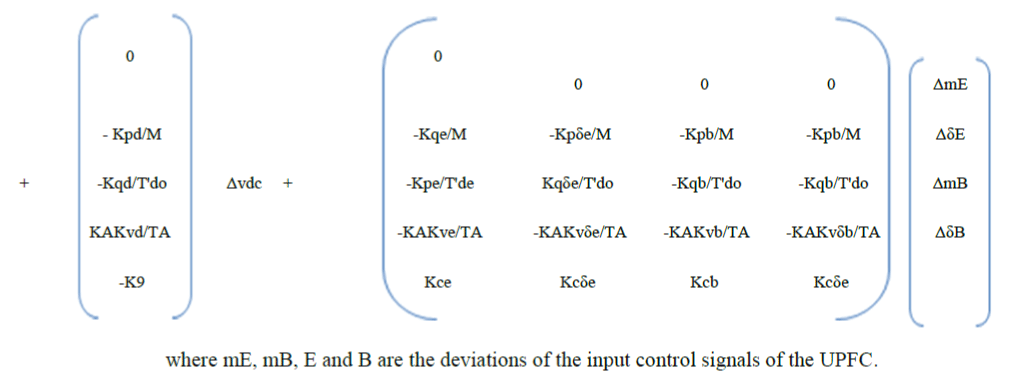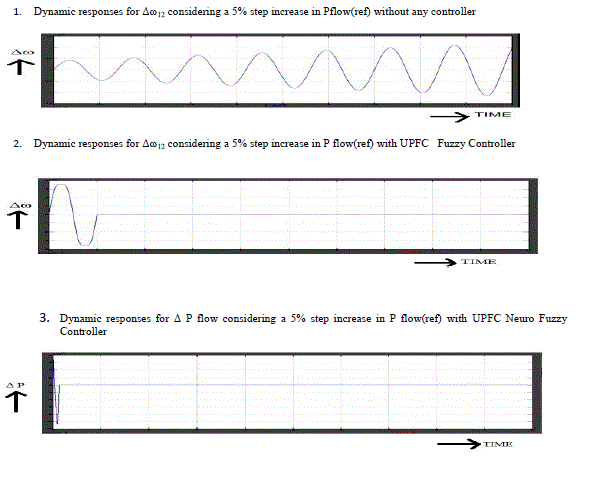ISSN ONLINE(2278-8875) PRINT (2320-3765)
ISSN ONLINE(2278-8875) PRINT (2320-3765)
Israel Babu Sirapangi1, Sadik Ahamad Khan2, Firoz Ali Md3
|
| Related article at Pubmed, Scholar Google |
Visit for more related articles at International Journal of Advanced Research in Electrical, Electronics and Instrumentation Engineering
Low Frequency Oscillations (LFO) occur in power systems because of lack of the damping torque in order to dominance to power system disturbances as an example of change in mechanical input power. Traditionally, power system stabilizers (PSS) are being used to damp these oscillations. Unified Power Flow Controller (UPFC) is a well-known FACTS device that can control power flow in transmission lines. It can also replace PSS to damp low frequency oscillations effectively through direct control of voltage and power. In this paper a liberalized Philips-Heffron model of a (Single Machine–Infinite Bus) power system with a unified power flow controller is considered and also in order to damp LFO, adaptive neuro-fuzzy controller for UPFC is designed and simulated. Simulation is performed for various types of loads and for different disturbances. Simulation results show good performance of neuro-fuzzy controller in damping LFO.
Keywords |
||||||||
| Neuro-Fuzzy Controller, Low Frequency,Oscillations (LFO), Unified Power Flow Controller (UPFC), Single Machine-Infinite Bus (SMIB), Pid controller | ||||||||
INTRODUCTION |
||||||||
| The Ability to control power flow in an electric power system without generation rescheduling or topology changes can improve the power system performance using controllable components, the line flows can be changed in such a way that thermal limits are not exceed, losses are minimized, stability margins are increased and contractual requirements are fulfilled without violating the economic generation dispatch. Flexible AC Transmission systems (FACTS) technology is the ultimate tool for getting the most out of existing equipment via faster control action and new capabilities. The most striking feature is the ability to directly control transmission line flows by structurally changing parameters of the grid and to implement high-gain type controllers based on fast switching. The application of FACTS devices to power system security has been an attractive ongoing area of research. In most of the reported studies, attention has been focused on the ability of these devices to improve the power system security by damping system oscillations and minimal attempts have been made to investigate the effect of these devices on power system reliability. The opportunities arise through the ability of FACTS controllers to control the interrelated parameters that governs the operation of transmission systems including series impedance and shunt impedance, current, phase angle and damping of oscillations at various frequencies below the rated frequency. These constraints cannot be overcome otherwise, while maintaining the required system stability, by mechanical means without lowering the useable transmission capacity. By providing added flexibility, FACTS controller can enable a line to carry power closer to its thermal rating. Mechanical switching needs to be supplemented by rapid response power electronics[13]. The facts technology can certainly be used to overcome any to the stability limits, in which case the ultimate limits would be thermal and dielectric. | ||||||||
| Static VAR controllers control only one of three important parameters (voltage, impedance, phase angle) determining the power flow in the AC power system viz. the amplitude of voltage at selected terminals of transmission line . It has long been realized that an all solid-state or advanced, static VAR compensator, which is true equivalent of ideal synchronous condenser, is technically feasible with the use of Gate Turn-Off (GTO) Thyristor. The UPFC is recently introduced FACTS controller which has the capability to control all the four transmission parameters. The UPFC not only performs the functions of STATCOM, TCSC, and the phase angle regulator but also provides additional flexibility by combining some of the functions of these controllers. | ||||||||
| This paper presents a new approach to the implementation of the UPFC based on a Neuro-fuzzy logic controller in a single Machine infinite bus power system. | ||||||||
DYNAMIC MODELING OF POWER SYSTEM WITH UPFC |
||||||||
| Fig. 1 shows a single-machine-infinite-bus (SMIB) system with UPFC. In Fig. 1 me, mb and δe, δb are the amplitude modulation ratio and phase angle of the reference voltage of each voltage source converter respectively. These values are the input control signals of the UPFC | ||||||||
| A linearized model of the power system is used in studying dynamic studies of power system. In order to consider the effect of UPFC in damping of LFO, the dynamic model of the UPFC is employed. The Dynamic model of the SMIB with UPFC can be represented as | ||||||||
 |
||||||||
 |
||||||||
ADAPTIVE NEURO-FUZZY CONTROLLER DESIGN |
||||||||
| Another controller is adaptive neuro-fuzzy controller. In this section, we will present the procedure of designing of the adaptive neuro-fuzzy controller. In this research, the neuro fuzzy controller has 2 inputs that are Δδ and Δω and it has 1 output that is f ∈ {ΔmE, ΔδE, ΔmB, ΔδB,} . For each input 20 membership functions and also 20 rules in the rules base is considered. Figure 5 demonstrates the structure of adaptive neuro-fuzzy controller for a sugeno fuzzy model with 2 inputs and 20 rules. | ||||||||
| In Figure 2, a Sugeno type of fuzzy system has the rule base with rules such as follows: | ||||||||
| 1. If Δδ is A1 and Δω is B1 then f1=p1 Δδ+q1 Δω+r1. | ||||||||
| 2. If Δδ is A2 and Δω is B2 then f2=p2 Δδ+q2 Δω+r2. | ||||||||
| μAi and μBi are the membership functions of fuzzy sets Ai and Bi for i=1,…,20. In evaluating the rules, we choose product for T-norm (logical and). | ||||||||
| Now Hybrid learning algorithm can be applied to obtain values of parameters. Hybrid learning algorithm is combination of linear and nonlinear parameters learning algorithm. Description for learning procedure can be found in [20]. This network is called adaptive by Jang and it is functionally equivalent to Sugeno type of a fuzzy system. It is not a unique presentation. With regard to the explanations presented and with the help of MATLAB software, adaptive neuro-fuzzy controller can be designed. The rules surface for designed controller is shown in figure 3. | ||||||||
| One of the advantages of using neuro-fuzzy controller is that we can utilize one of the designed controllers for instance Δme controller in place of the other controllers. While if we use conventional lead-lag controller, for each controls parameters, a controller must be designed. | ||||||||
SIMULATION RESULTS |
||||||||
 |
||||||||
CONCLUSION |
||||||||
| In this paper, A comprehensive approach for optimum design of UPFC controllers (i.e. STATCOM control and SSSC control) has been presented for a single machine system. The adverse interaction between PSS and SSSC control has been compensated, by providing UPFC based damping controller and UPFC capability in transient stability improvement and damping LFO of power systems, an adaptive neuro-fuzzy controller for UPFC was presented. The controller was designed for a single machine infinite bus system. Then simulation results for the system including neuro fuzzy controller were compared with simulation results for the system including conventional UPFC controller. Simulations were performed for different kinds of loads. Comparison showed that the proposed adaptive neuro-fuzzy controller has good ability to reduce settling time and reduce amplitude of LFO. | ||||||||
Figures at a glance |
||||||||
|
||||||||
References |
||||||||
|